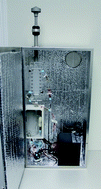Characterization and optimization of an online system for the simultaneous measurement of atmospheric water-soluble constituents in the gas and particle phases†
Abstract
In this work we present the results of extensive characterization and optimization of the Ambient Ion Monitor-Ion Chromatograph (AIM-IC) system, an instrument developed by URG Corp. and Dionex Inc. for simultaneous hourly measurements of the water-soluble chemical composition of atmospheric fine particulate matter (PM2.5) and associated precursor gases. The sampling assembly of the AIM-IC consists of an inertial particle size-selection assembly, a parallel-plate wet denuder (PPWD) for the collection of soluble gases, and a particle supersaturation chamber (PSSC) for collection of particles, in series. The analytical assembly of the AIM-IC consists of anion and cation IC units. The system detection limits were determined to be 41 ppt, 5 ppt, and 65 ppt for gas phase NH3(g), SO2(g), and HNO3(g) and 29 ng m−3, 3 ng m−3, and 45 ng m−3 for particle phase NH4+, SO42−, and NO3− respectively. From external trace gas calibrations with permeation sources, we determined that the AIM-IC is biased low for NH3(g) (11%), SO2(g) (19%), and HNO3(g) (12%). The collection efficiency of SO2(g) was found to strongly depend on the composition of the denuder solution and was found to be the most quantitative with 5 mM H2O2 solution for mixing ratios as high as 107 ppb. Using a cellulose membrane in the PPWD, the system responded to changes in SO2(g) and HNO3(g) within an hour, however for NH3(g), the timescale can be closer to 20 h. With a nylon membrane, the instrument response time for NH3(g) was significantly improved, becoming comparable to the responses for SO2(g) and HNO3(g). Performance of the AIM-IC for collection and analysis of PM2.5 was evaluated by generating known number concentrations of ammonium sulfate and ammonium nitrate particles (with an aerodynamic diameter of 300 nm) under laboratory conditions and by comparing AIM-IC measurements to measurements from a collocated Aerosol Mass Spectrometer (AMS) during a field-sampling campaign. On average, the AIM-IC and AMS measurements agreed well and captured rapid ambient concentration changes at the same time. In this work we also present a novel inlet configuration and plumbing for the AIM-IC which minimizes sampling inlet losses, reduces peak smearing due to sample carryover, and allows for tower-height sampling from the base of a research tower.


 Please wait while we load your content...
Please wait while we load your content...